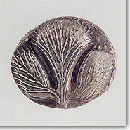


  | |
|
The term tyrannos probably comes from Asia Minor. It was first used by Archilochus in the mid-7th century B.C. as a synonym for the term basileus. But already in the 6th century Solon linked tyranny with violence. Yet tyrannoi such as Cleobulus or Periander of Corinth were among the Seven Sages. Normally tyrants were members of aristocratic families who either held on to power illegitimately after their term of service had ended or seized it by force. Imposition of a tyrant was the outcome of eupatrid refusal to come up with a solution to the stresses caused by social inequality and the agricultural crisis. To consolidate their power, they governed simply with the help of certain supporters of theirs. They frequently went as far as to systematically persecute the aristocratic families that were their opponents, exiling or executing their more ambitious members and confiscating their property. |  |
The commonest picture of the tyrant is of a person who looks for support among the lower strata, satisfying their demands at the expense of the great landowners. Certain tyrannoi in fact went so far as to redistribute land and generally favour traders and craftsmen. But there are no indications that as a whole they systematically followed a populist policy. At all events, it is a fact that the measures they took did in many instances liberate the creative forces of the cities, thus providing the necessary conditions for their economic growth. According to the ancient historians, they also funded major building works, in order to publicize their power and keep the demos employed.
In Lower Italy and Sicily the tyrannies we know of were imposed with some delay, in the late 6th century, and under different social conditions. The cities of Magna Graecia had to cope with not only internal conflict but interference by the Carthaginians and risings of the indigenous inhabitants, who were frequently restricted to a position similar to that of the helots at Sparta. At any rate, in every case the duration of these regimes did not exceed two generations. Their violent overthrow, with the tyrannos in some cases being murdered, was interpreted in the 5th century as proof that these regimes were constitutional deviations.
|
| |
|
Note: Click on pictures to see a short description. | |